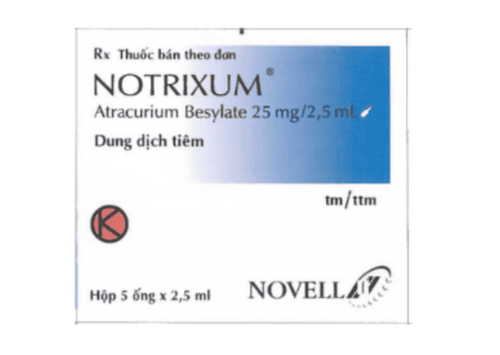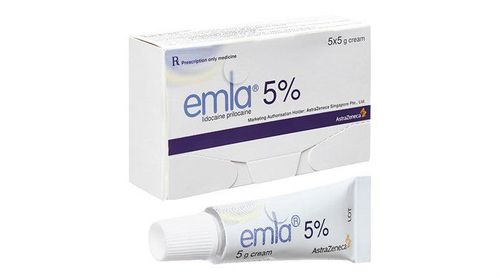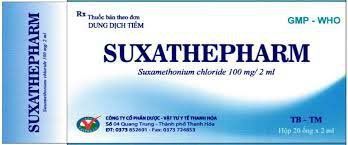This is an automatically translated article.
Sanbeproanes is a prescription drug that is prescribed by a doctor for intravenous anesthesia. Sanbeproanes drug is in the form of an injectable emulsion. Packing specification is that the drug is packaged in the form of a box of 5 tubes x 20 ml.
1. What is Sanbeproanes?
Sanbeproanes medicine has the main active ingredient Propofol with the strength of 200mg/20ml, which is prescribed by a doctor. This is a type of anesthetic, anesthetic is indicated for intravenous anesthesia. Sanbeproanes drug is in the form of an injectable emulsion. Packing specification is that the drug is packaged in the form of a box of 5 tubes x 20 ml.
2. What is Sanbeproanes used to treat?
Sanbeproanes is a short acting intravenous anesthetic suitable for:
Induction and maintenance of anesthesia in adults and children over 3 years of age. Sedation for surgical and diagnostic procedures, alone, or in combination with local or regional anesthetics, in adults and children over the age of 16 years. Propofol 1% can also be used to induce sleep in persons over 16 years of age on assisted ventilation in the intensive care unit. Used for induction or maintenance of anesthesia. Use of drugs during intubation in people on ventilators in the intensive care unit for sedation.
3. Usage and dosage of Sanbeproanes
3.1. How to use Sanbeproanes Sanbeproanes drugs are indicated for use by injection.
3.2. Subjects of use: Sanbeproanes can only be used when prescribed by a medical doctor.
3.3. Dosage of the drug Sanbeproanes Dosage with sedative effect for adults: should be limited to 3 days, 0.3 - 4 mg/kg/hour, should not be used in children for sedation purposes.
For adults: In people without pre-anesthesia and those with pre-anesthesia, the active ingredient Propofol should be adjusted according to the individual response until the patient shows signs of onset of anesthesia.
Most adults under 55 need 1.5-2.5mg of Propofol/kg. The total dose can be reduced by reducing the infusion rate from 2ml to 5ml/min or 20mg to 30mg/min. Children over 5 years old, the need is usually less. Elderly: In the elderly, the dose required for induction of anesthesia with Propofol is reduced. When reducing the dose, the individual's physical condition and age should be taken into account. This reduced dose should be infused at a slower rate and adjusted according to response. For children: Active ingredient Propofol is not used to induce anesthesia in children under 3 years of age. When administering drugs to induce anesthesia in children, Propofol should be administered slowly until clinical signs of induction of anesthesia appear. Most children over 8 years of age may need about 2.5mg of Propofol/kg for induction of anesthesia.
4. In case of over/missing dose of Sanbeproanes
Case of drug overdose: Overdosage of Sanbeproanes drug caused by complications can cause respiratory and circulatory failure. The treating doctor will prescribe the management of respiratory failure by artificial ventilation with oxygen. When the patient has circulatory failure, the patient should be placed with the head low and volume compensated and vasopressor drugs used if the condition becomes severe.
In case of missed dose: Information on how to handle a missed dose of Sanbeproanes is being updated.
5. Undesirable effects of the drug Sanbeproanes
Induction with Propofol 1% is usually gentle with little manifestation of irritation. The most commonly reported adverse events were predictable anesthetic pharmacological reactions, such as hypotension. Due to the nature of the anesthetic procedure and the condition of the patient in the intensive care unit, reported events related to anesthesia and intensive care procedures may also be related to the procedure performed or to the patient's condition. individual medical condition.
Very common undesirable effects are systemic disorders and conditions at the infusion site: Local pain during induction of anesthesia.
Common adverse effects with frequency > 1/100, < 1/10)
Vascular disorders: causing hypotension Heart rhythm disturbances: bradycardia Respiratory, chest and mediastinal disorders: transient signs of apnea during induction of anesthesia. Gastrointestinal disorders: nausea and vomiting during the recovery period. Nervous system disorders: headache during the recovery period. Systemic disorders and injection site conditions: withdrawal symptoms in children. Vascular disorders: flushing in children. Uncommon side effects with frequency > 1/1000, < 1/100
Vascular disorders: risk of thrombosis and phlebitis. Rare adverse effects with > 1⁄10 000, < 1⁄1000
For the nervous system: epileptic movements, including convulsions and flexing during anesthesia induction, maintenance and recovery . You need to proactively notify the treating doctor of any unwanted effects encountered when using Sanbeproanes.
6. Some notes when using Sanbeproanes
6.1. Sanbeproanes Contraindications Sanbeproanes is contraindicated in people who are known to be allergic to Propofol 1% or any of its ingredients. Contraindicated for induction and maintenance of anesthesia in children under 3 years of age. Contraindicated for sedation in children under 16 years of age. 6.2. Recommendations when using Sanbeproanes Must be absolutely sterile when injecting. Caution should be exercised in people with debilitation, the elderly, people with heart, lung, kidney or liver damage, reduced blood flow, epilepsy, patients with drug dependence, drug sensitivities, people patients with impaired lipid metabolism, who are receiving intravenous infusion of other lipid solutions. If you need more information about the drug, please consult your doctor. You need to proactively inform your doctor about the unwanted effects encountered when using the drug. 6.3. Use of Sanbeproanes in pregnancy and lactation
Use of Sanbeproanes in pregnancy: Active ingredient Propofol 1% should not be used during pregnancy. However, the active ingredient Propofol 1% has been used for termination of pregnancy during the first trimester. Use of Sanbeproanes with lactation: The safety of the infant has not been established when a nursing mother uses the active ingredient Propofol 1%. Effects of Sanbeproanes on the ability to drive and use machines: Information on the effect of the drug on the ability to drive and use machines is being updated. Above is all information about Sanbeproanes drug, patients need to carefully read the instructions for use, consult a doctor / pharmacist before using. Absolutely do not arbitrarily buy Sanbeproanes to treat diseases at home, because there may be unwanted side effects on health.
Please dial HOTLINE for more information or register for an appointment HERE. Download MyVinmec app to make appointments faster and to manage your bookings easily.













